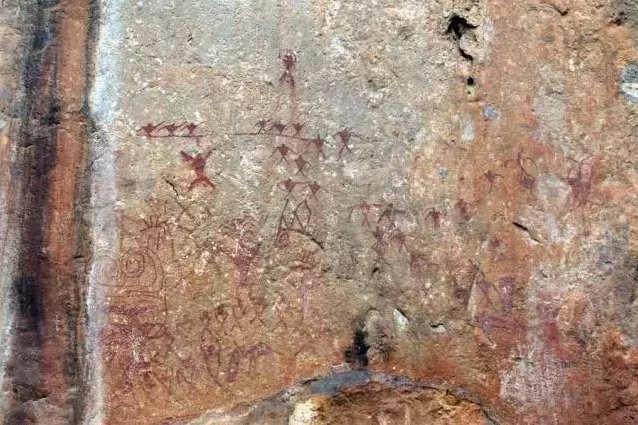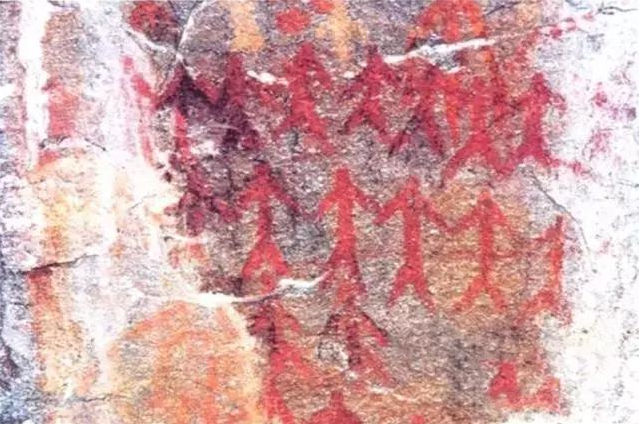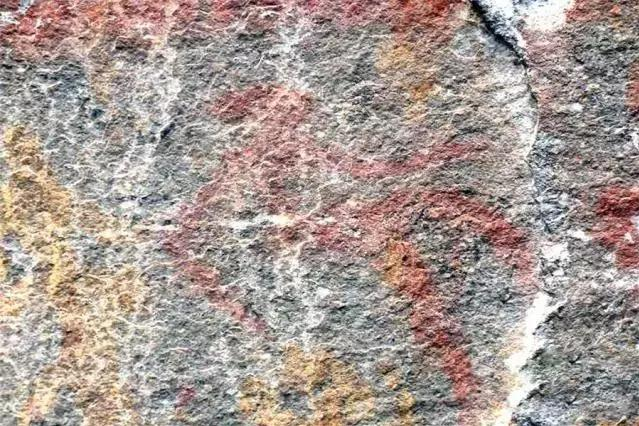Cliff Paiting of Cangshan Mountain in Yangbi County, Dali
Overview
The Cliff Painting of Cangshan Mountain (漾濞苍山崖画) is a remarkable archaeological site located on the eastern bank of the Yangbi River (漾濞江) and the western slope of Cangshan Mountain (点苍山). This site is affectionately known by locals as the “Place Where Immortals Play Chess” (仙人下棋处) due to its mystical aura. The cliff’s summit is shaped like a straw hat, leading to its nickname “Straw Hat Stone” (草帽石). The cliff painting is etched into a colossal rock that stands 8.2 meters high, with dimensions of 8.7 meters at the top and 18 meters at the base. Besides the upper right section, which is covered by corrosive lava, the artwork currently spans approximately seven square meters, measuring around 4 meters in height and 5.5 meters in width. The painting consists of three distinct layers, predominantly in ochre red, with yellow figures and handprints. Experts have confirmed that this is the first ancient cliff painting discovered in the Yangbi River basin, officially named “Cliff Painting of Cangshan Mountain” (漾濞苍山崖画). Numerous caves and stone chambers in the vicinity further enhance its archaeological significance. Standing before this mysterious rock evokes a feeling of traveling back to three thousand years ago.
Location and Significance
The cliff painting is located about three kilometers southeast of Jinniu Village (金牛村) in Cangshan West Town (苍山西镇), Yangbi Yi Autonomous County (漾濞彝族自治县), at an elevation of 2070 meters. The topography resembles a chair, with a gentle slope where the massive rock is situated. It possesses considerable artistic and collectible value, filling a significant void in the archaeological record of Dali Prefecture (大理州).
Key Information
- Chinese Name: 漾濞苍山崖画
- Address: Cangshan West Town, Yangbi Yi Autonomous County, Yunnan Province (云南省漾濞彝族自治县苍山西镇)
- Altitude: 2070 m
- Significance: Fills the previous gap of no cliff paintings in Dali Prefecture (大理州).
Description of the Painting
The rock consists of granite and measures 19.9 meters in width and 8.25 meters in height. The cliff’s top features a relatively flat area, oriented at an angle of 59 degrees northeast. The base is a muddy flatland. The cliff painting measures 5.6 meters in length and 4 meters in width, covering a total area of 22.4 square meters. It is divided into five groups with earthy yellow and ochre red lines. Due to natural weathering and lava coverage, over 200 identifiable images can be discerned, including:
- Pastoral Scenes: Herding and gathering wild fruits.
- Hunting: Evidence of hunting activities, especially wild boar.
- Dance: Depictions of social gatherings and celebrations.
- Housing: Representations of stilt houses.
Experts across the nation believe this painting predates the Western Han Dynasty (西汉) and may represent the oldest form of prehistoric art in the region. It shares similarities with cliff paintings found in Guangxi and the Northwest while exhibiting notable differences from other artworks discovered in Yunnan. The concentrated and rich imagery makes it a rare cliff painting of considerable importance.
Cultural and Historical Significance
The discovery of this cliff painting fills a crucial gap in understanding ancient social history, ethnic history, and the development of art in the Dali region. It provides valuable insights into the life of early inhabitants, confirming that humans have lived on the western slopes of Cangshan for millennia. Additionally, it plays a vital role in expanding the cultural corridor of Cangshan and promoting tourism. This site is undoubtedly a priceless piece of ancient cultural heritage.
Additional Findings
The cliff painting is situated approximately five kilometers east of the confluence of three rivers: the Xiehe River (西洱河), Yangbi River, and Shunbi River (顺濞河). Discovered in 1994, it remains the only known ancient rock painting within Dali Prefecture. The artwork is etched on a prominent rock wall that faces south, characterized by:
- Height: 9 meters
- Width: 13 meters at the base
- Shape: Truncated rectangular, partially obscured by evergreen shrubs
- Structure: Comprises three distinct layers
Layer Details
- First Layer:
- Located on the upper right side, 5 meters above ground.
- Condition: Severely damaged, with approximately 2 square meters of recognizable area.
- Content: Faint images of several cows, with one cow clearly depicted.
- Second Layer:
- Contains over ten identifiable figures and handprints.
- The figures are simply drawn, lacking clothing and facial features.
- Handprint: A robust impression of a left hand, indicative of adult male size.
- Third Layer:
- Features a rich array of images, including various animals, handprints, and traditional dwellings.
- The images include:
- Domestic Animals: Cows, pigs, chickens, and dogs.
- Structures: Stilt houses depicted with supporting columns.
- Human Figures: A group of 21 dancers arranged in a coordinated manner, demonstrating social interaction.
How to Get There
To reach the Cliff Painting of Cangshan Mountain in Yangbi County:
- From Dali City (大理市): Travel approximately 40 kilometers to Yangbi County.
- Transportation Options:
- By Car: Drive via local roads to Cangshan West Town, following signs to Jinniu Village.
- By Public Transport: Take a bus from Dali to Yangbi County, then hire a local taxi to the site.



















